Flag of the United Kingdom
 | |
| Union Flag, Union Jack, British flag, UK flag | |
| Use | National flag |
|---|---|
| Proportion | 1:2 |
| Adopted | 1 January 1801 |
| Design | A white-fimbriated symmetric red cross on a blue field with a white-fimbriated counterchanged saltire of red and white. |
| Alternative 3:5 ratio | |
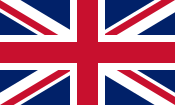 | |
| Proportion | 3:5 |
| Red Ensign | |
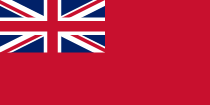 | |
| Use | Civil ensign |
| Proportion | 1:2 |
| Design | A red field with the Union Flag in the canton. See Red Ensign. |
| Proportion | 1:2 |
| Design | A blue field with the Union Flag in the canton. See Blue Ensign. |
| White Ensign | |
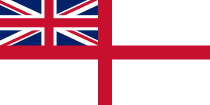 | |
| Use | Naval ensign |
| Proportion | 1:2 |
| Design | A symmetric red cross on a white field with the Union Flag in the canton. See White Ensign. |
| Royal Air Force Ensign | |
 | |
| Use | Air force ensign |
| Proportion | 1:2 |
| Design | A field of air force blue with the Union Flag in the canton and the RAF roundel in the middle of the fly. |
The national flag of the United Kingdom is the Union Jack, also known as the Union Flag.[a]
The design of the Union Jack dates back to the
The flag proportions on land and the war flag used by the British Army have the proportions 3:5.[10] The flag's height-to-length proportions at sea are 1:2.[11]
The earlier
The Union Flag shall be azure, the Crosses saltire of Saint Andrew and Saint Patrick quarterly per saltire, counter-changed, argent and gules, the latter fimbriated of the second, surmounted by the Cross of Saint George of the third fimbriated as the saltire.[13]
No official standardised colours were specified, although the Flag Institute defines the red and royal blue colours as Pantone 186 C and Pantone 280 C, respectively.[14]
Flying the flag
 |  | ||||||||||||
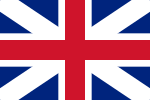 St Patrick's Cross )(Ireland | |||||||||||||
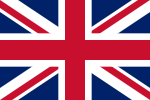 1801 (United Kingdom ) | |||||||||||||
The Union Flag can be flown by any individual or organisation in Great Britain on any day of their choice. Legal regulations restrict the use of the Union Flag on government buildings in Northern Ireland. Long-standing restrictions on UK government use of the flag elsewhere were abolished in July 2007.[15][16]
Upside-down
While the flag appears symmetric, the white lines above and below the diagonal red are different widths. On the side closer to the flagpole (or on the left when depicted on paper), the white lines above the diagonals are wider; on the side farther from the flagpole (or on the right when depicted on paper), the converse is true. Thus, no change will be apparent when rotating the flag 180 degrees, but if mirrored the flag will be upside-down.
Placing the flag upside down is considered
St Patrick's saltire
Because of the relative positions of the saltires of St Patrick and St Andrew, the UK flag is not symmetrical. The red saltire of St Patrick is offset such that it does not relegate the white saltire of St Andrew to a mere border. St Andrew's saltire has the higher position at the hoist side with St Patrick's saltire in the higher position on the opposite side.
Half-mast
The Union Flag is flown from UK government buildings at half-mast in the following situations:[19]
- from the announcement of the death of the Sovereign (an exception is made for Proclamation Day– the day the new Sovereign is proclaimed, when the Flag is flown at full mast from 11 am to sunset)
- the day of the funeral of a member of the British royal family
- the funeral of a foreign Head of State
- the funeral of a former British Prime Minister
The Sovereign sometimes declares other days when the Union Flag is to fly at half-mast. Half-mast means the flag is flown two-thirds of the way up the flagpole with at least the height of the flag between the top of the flag and the top of the flagpole.[20]
Flying from public buildings
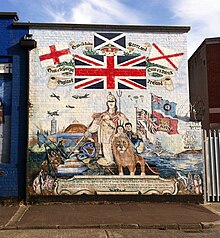
Until July 2007, the Union Flag was only flown on UK government buildings on a limited number of special days each year. The choice of days was managed by the Department for Culture, Media and Sport (DCMS).[15] Government buildings are those used by civil servants, the Crown, or the armed forces. They were not applicable to private citizens, corporations, or local authorities.[15]
On 3 July 2007, the Justice Secretary Jack Straw laid a green paper before Parliament entitled The Governance of Britain.[16] Alongside a range of proposed changes to the constitutional arrangements of the UK was a specific announcement that there would be consultation on whether the rules on flag-flying on UK government buildings should be relaxed.
Two days later, Prime Minister Gordon Brown announced that with immediate effect the Union Flag would fly from the flag pole above the front entrance of 10 Downing Street on every day of the year. The intention was to increase feelings of British national identity. Other UK government departments were asked to follow this lead, and all government buildings in Whitehall did so.[21][22][23][24][25][26]
Flag days
The flag days directed by the DCMS include birthdays of members of the
Since 2023, the relevant days have been:
- 9 January: the birthday of The Princess of Wales
- 20 January: the birthday of The Duchess of Edinburgh
- 19 February: the birthday of The Duke of York
- Second Monday in March: Commonwealth Day
- 10 March: the birthday of The Duke of Edinburgh
- 9 April: the anniversary of the wedding of The King and The Queen
- 6 May: the anniversary of the coronation of The King and The Queen
- A Saturday in June: the Official Birthday of The King
- 21 June: the birthday of The Prince of Wales
- 17 July: the birthday of The Queen
- 15 August: the birthday of The Princess Royal
- 8 September: the anniversary of the accession of The King
- Second Sunday in November: Remembrance Sunday
- 14 November: the (actual) birthday of The King
In addition, the flag should be flown in the following areas on the specified days:
- Wales, 1 March: Saint David's Day
- Northern Ireland, 17 March: Saint Patrick's Day
- England, 23 April: Saint George's Day
- Scotland, 30 November: Saint Andrew's Day
- Greater London: the opening and proroguing of Parliament
Some non-central government bodies still continue to follow the flag days.
In Scotland, the Scottish Government has decreed that the Flag of Scotland ("the Saltire") will fly on all its buildings every day from 8 am until sunset, but there is no specific policy on flying the Union Flag and as such it is sometimes flown alongside the Saltire and sometimes omitted. An exception is made for "national days". On these days, the Saltire shall be lowered and replaced with the Union Flag. These are the same as the flag days noted above with the exception of:
- 3 September: Merchant NavyDay
On Saint Andrew's Day, the Union Flag can only be flown if the building has more than one flagpole—the Saltire will not be lowered to make way for the Union Flag if there is only one flagpole.[28]
Welsh representation
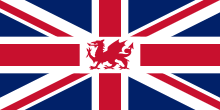
In November 2007 the then culture minister
Northern Ireland
In
The
Scottish independence
As of 2013, numerous proposals were made about how the Union Flag might be altered to create a flag for the union of England, Wales and Northern Ireland after possible Scottish independence.[34] The College of Arms stated that there would be no need to change the flag in those circumstances, and the existing flag could continue to be used if desired.[35] Regarding the removal of Scottish heraldic features from the Union Flag, the Court of the Lord Lyon stated in 2012 that "[that] would be speculation at this stage, and we could only cross that bridge if we came to it."[36]
Construction sheets
See also
- Commonwealth's flags
- Historical flags of the British Empire and the overseas territories
- List of United Kingdom flags – a list of flags used within the United Kingdom, the Crown Dependencies and the British overseas territories.
- List of English flags – a list of flags used within England
- List of Cornish flags – a list of flags used within Cornwall
- List of Northern Irish flags– a list of flags used within Northern Ireland
- List of Scottish flags – a list of flags used within Scotland
- List of Welsh flags – a list of flags used within Wales
- List of English flags – a list of flags used within England
- List of Irish flags– a list of flags used within the Republic of Ireland
- National colours of the United Kingdom
- Protectorate Jack
Notes
- OED has definition 21 "Something insignificant, or smaller than the normal size" and gives examples from 1530 to 2014 of this usage.[5] Further examples in the compounds section at 2b illustrate this.[5] The original maritime flag use of jack was "A ship's flag of a smaller size than the ensign, used at sea as a signal, or as an identifying device".[6] The Jack was flown in the bows or from the head of the spritsail mast to indicate the vessel's nationality: "You are alsoe for this present service to keepe in yor Jack at yor Boultspritt end and yor Pendant and yor Ordinance"[7] The Union Flag when instantiated as a small jack became known as the "Union Jack" and this later term transferred to more general usage of the Union Flag.[8] Also later a short flagpole was placed in the bows of a ship to fly the jack, this became known as the jackstaff.[9]
References
- ^ "The Union Jack or The Union Flag?". The Flag Institute. 20 June 2014. Archived from the original on 13 June 2013. Retrieved 3 December 2015.
- ^ The Lords Commissioners of the Admiralty (1911) [1908], Manual of Seamanship, vol. I, London: HMSO, p. 20
- ^ a b "-kin". Oxford English Dictionary (Online ed.). Oxford University Press. (Subscription or participating institution membership required.)
- ^ "John". Oxford English Dictionary.
- ^ a b c "Jack". Oxford English Dictionary.
- ^ "Jack". Oxford English Dictionary.
- ^ 1633 quotation cited in "Jack". Oxford English Dictionary.
- ^ "Union flag". Oxford English Dictionary (Online ed.). Oxford University Press. (Subscription or participating institution membership required.) "Compare slightly later Union Jack"
- ^ "jackstaff". Oxford English Dictionary (Online ed.). Oxford University Press. (Subscription or participating institution membership required.)
- ^ The Flag Institute Archived 10 September 2022 at the Wayback Machine It says "The proportions of the flag are 30 units wide by 50 units long", or in other words; the flag proportions are 3:5.
- ^ United Kingdom, flag of the Archived 17 May 2013 at the Wayback Machine, for flag ratio see flag caption
- Orders in Council; Official creation of the Union Flag – 1606."
- ^ Max Cryer, Curious English Words and Phrases: The Truth Behind the Expressions We Use (2012), p. 395: "When Britain's official flag settled down in 1801, its exact design and colouring were meticulously written out by Order of Council which described it as 'the Union Flag'... The correct formal wording of the Order of Council, 1801, was..." &c.
- ^ "Union Flag: Specification". The Flag Institute. Archived from the original on 7 August 2021. Retrieved 7 August 2021.
- ^ a b c Department for Culture, Media and Sport: Flag Flying Archived 5 February 2007 at the Wayback Machine
- ^ a b The Governance of Britain Archived 1 December 2007 at the Wayback Machine, for flying the Union Flag, see pp. 57–58
- ^ Matthew Tempest, "Paisley to stand down as MEP", The Guardian, 19 January 2004. "After receiving almost 30% of the overall Northern Ireland vote in the 1979 European election, he became the first MEP to speak in the parliament when he protested that the Union Flag was flying upside down." Archived 2 February 2017 at the Wayback Machine.
- ^ "Defence Secretary apologises for flag blunder", BBC News, 13 November 1997.
- ^ "Flying the Flag on UK Government Buildings - Frequently Asked Questions". Department for Culture, Media and Sport. Archived from the original on 16 October 2008.
- ^ "Flying the Flag on UK Government Buildings - Frequently Asked Questions - Q. What is half mast?". Department for Culture, Media and Sport. Archived from the original on 16 October 2008.
- Prime Minister's Spokesman (6 July 2007). "Morning Press Briefing". 10 Downing Street. Archived from the originalon 9 August 2007.
- ^ Carlin, Brendan (7 July 2007). "Union flag already flying all year round". The Daily Telegraph. Archived from the original on 3 November 2007.
- ^ "Brown lifts ban on national flag", BBC News, 6 July 2007. Archived 6 February 2009 at the Wayback Machine.
- ^ Summers, Deborah (6 July 2007). "Brown flies flag for Britain". Newsblog. The Guardian. Archived from the original on 8 June 2008.
- ^ Webster, Philip (6 July 2007). "Union Jack will fly over No 10 permanently 'to show values'". The Times. Archived from the original on 8 October 2021.
- ^ "Gordon orders Whitehall to fly the flag in boost for Britishness" Archived 19 August 2009 at the Wayback Machine Evening Standard 6 July 2007
- ^ Dates for flying the Union Flag on UK government buildings in 2020. Archived 23 September 2020 at the Wayback Machine Gov.uk. Published 27 February 2013. Updated 22 January 2020. Retrieved 29 September 2020.
- ^ "Royal and ceremonial" Archived 15 October 2008 at the Wayback Machine Scottish Government
- ^ Wintour, Patrick (28 November 2007). "Minister proposes a redesign for the union flag" Archived 1 December 2016 at the Wayback Machine, The Guardian
- ^ Cleland, Gary (27 November 2007). "Union Jack should include Welsh flag, says MP" Archived 31 January 2018 at the Wayback Machine, Daily Telegraph
- ^ "The Flags Regulations (Northern Ireland) 2000". Opsi.gov.uk. Archived from the original on 9 December 2009. Retrieved 14 June 2010.
- ^ "The Flags Regulations (Northern Ireland) (Amendment) 2002". Opsi.gov.uk. Archived from the original on 9 December 2009. Retrieved 14 June 2010.
- ^ "Police Emblems and Flags Regulations (Northern Ireland) 2002". Opsi.gov.uk. Archived from the original on 9 December 2009. Retrieved 14 June 2010.
- ^ Sam Judah (4 December 2013). "What would the union jack look like if the Scottish bit was removed?". BBC News. Archived from the original on 27 August 2018. Retrieved 21 July 2018.
- ^ "Union Flag: What happens if Scotland wins independence?". ITV News. 27 November 2013. Archived from the original on 16 May 2020. Retrieved 4 December 2013.
- ^ "Would the blue have to be taken out of Union flag if Scotland became independent?". Daily Record. 7 June 2012. Archived from the original on 22 February 2014. Retrieved 4 December 2013.
External links
 Media related to Flags of the United Kingdom at Wikimedia Commons
Media related to Flags of the United Kingdom at Wikimedia Commons Quotations related to Flag of the United Kingdom at Wikiquote
Quotations related to Flag of the United Kingdom at Wikiquote- United Kingdom at Flags of the World
- British Monarchy – Union Flag
- British Armed forces Grenadiers Colour Archived 31 October 2014 at the Wayback Machine



